Analysis of Global Positioning System Technology and Applications
VerifiedAdded on 2023/04/22
|9
|2433
|384
Report
AI Summary
This report delves into the Global Positioning System (GPS), a communication technology developed by the U.S. Department of Defense, utilizing orbiting satellites to enable location identification. The report outlines the fundamental methods used to operate GPS, including the space, control, and user segments, explaining the underlying networking principle of trilateration. It explores the applications of GPS across various sectors like military, financial services, telecommunications, and road transportation, while also addressing its drawbacks, such as accuracy issues, battery dependency, and security concerns. Furthermore, the report evaluates the reliability of data and information used, assessing accuracy, authority, objectivity, currency, and coverage of the sources. In conclusion, the report provides a comprehensive overview of GPS technology, its operational methods, applications, and limitations.
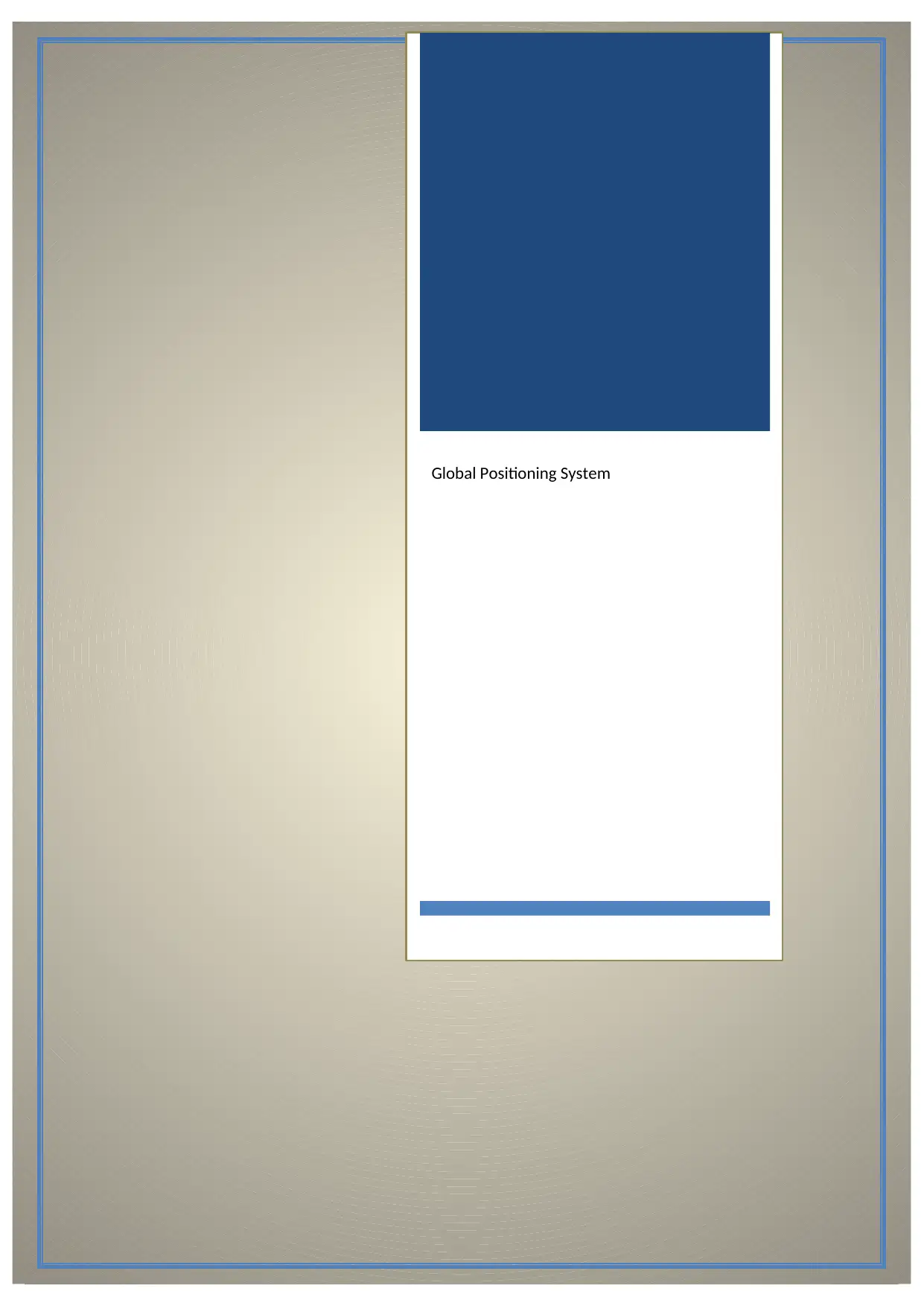
Global Positioning System
Paraphrase This Document
Need a fresh take? Get an instant paraphrase of this document with our AI Paraphraser

DATA COMMUNICATION AND NETWORK ROUTING
1
Contents
Introduction...............................................................................................................................2
1. Fundamental techniques or methods utilized to operate the GPS technology.................2
A. The space segment method............................................................................................2
B. Control segment..............................................................................................................2
C. User segment..................................................................................................................3
Underlying networking principle............................................................................................3
2. Drawbacks and potential applications of the global positioning system...........................3
Issues concerning accuracy and efficiency.............................................................................4
Dependent on the battery life................................................................................................4
Concerns about the security and privacy...............................................................................4
Applications of the global positioning system.......................................................................4
Military................................................................................................................................4
Financial services................................................................................................................5
Telecommunications...........................................................................................................5
Road transportation............................................................................................................5
3. Reliability of data and information.....................................................................................5
Accuracy.................................................................................................................................5
Authority.................................................................................................................................5
Objectivity...............................................................................................................................6
Currency.................................................................................................................................6
Coverage.................................................................................................................................6
Conclusion..................................................................................................................................6
References..................................................................................................................................7
1
Contents
Introduction...............................................................................................................................2
1. Fundamental techniques or methods utilized to operate the GPS technology.................2
A. The space segment method............................................................................................2
B. Control segment..............................................................................................................2
C. User segment..................................................................................................................3
Underlying networking principle............................................................................................3
2. Drawbacks and potential applications of the global positioning system...........................3
Issues concerning accuracy and efficiency.............................................................................4
Dependent on the battery life................................................................................................4
Concerns about the security and privacy...............................................................................4
Applications of the global positioning system.......................................................................4
Military................................................................................................................................4
Financial services................................................................................................................5
Telecommunications...........................................................................................................5
Road transportation............................................................................................................5
3. Reliability of data and information.....................................................................................5
Accuracy.................................................................................................................................5
Authority.................................................................................................................................5
Objectivity...............................................................................................................................6
Currency.................................................................................................................................6
Coverage.................................................................................................................................6
Conclusion..................................................................................................................................6
References..................................................................................................................................7
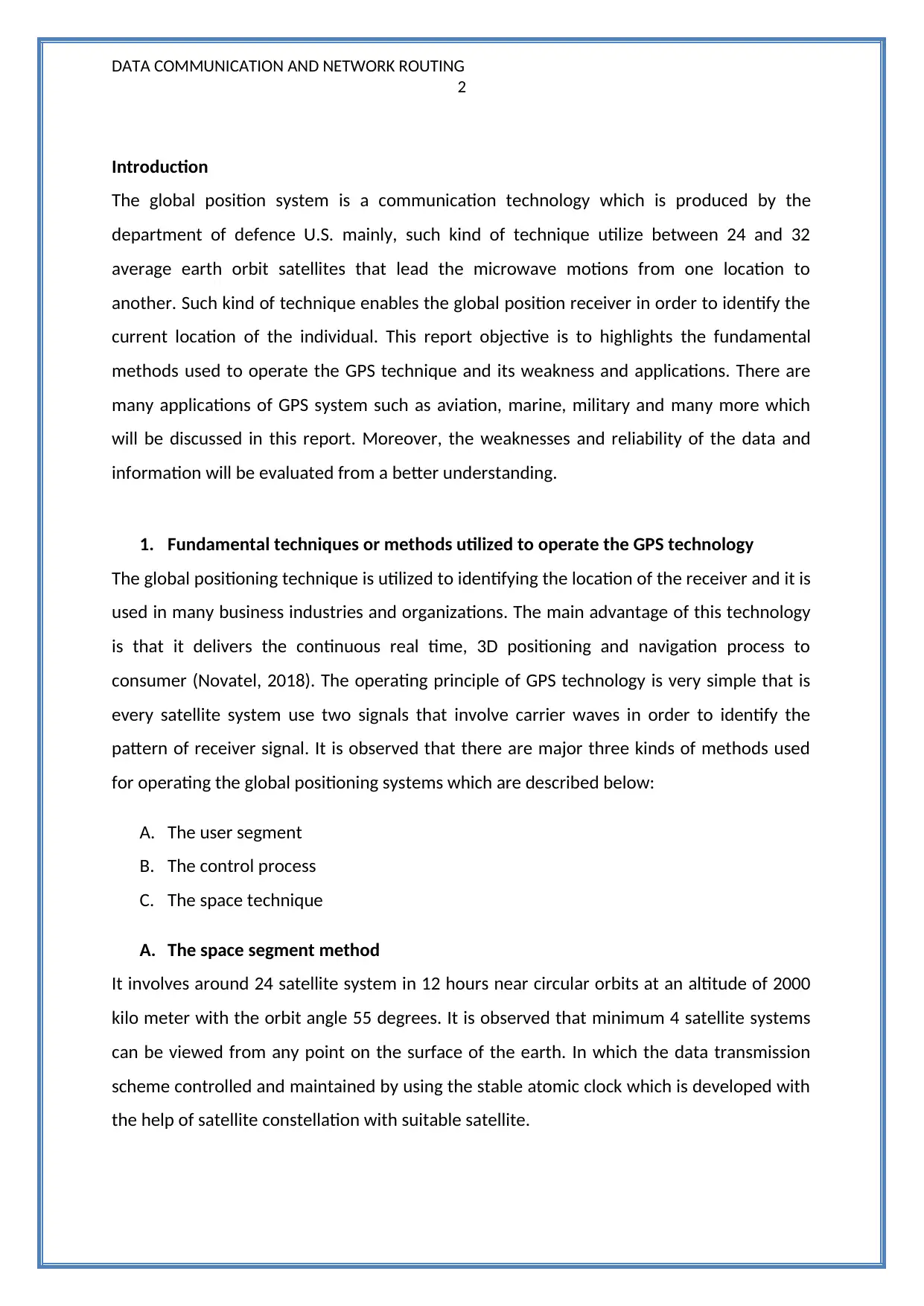
DATA COMMUNICATION AND NETWORK ROUTING
2
Introduction
The global position system is a communication technology which is produced by the
department of defence U.S. mainly, such kind of technique utilize between 24 and 32
average earth orbit satellites that lead the microwave motions from one location to
another. Such kind of technique enables the global position receiver in order to identify the
current location of the individual. This report objective is to highlights the fundamental
methods used to operate the GPS technique and its weakness and applications. There are
many applications of GPS system such as aviation, marine, military and many more which
will be discussed in this report. Moreover, the weaknesses and reliability of the data and
information will be evaluated from a better understanding.
1. Fundamental techniques or methods utilized to operate the GPS technology
The global positioning technique is utilized to identifying the location of the receiver and it is
used in many business industries and organizations. The main advantage of this technology
is that it delivers the continuous real time, 3D positioning and navigation process to
consumer (Novatel, 2018). The operating principle of GPS technology is very simple that is
every satellite system use two signals that involve carrier waves in order to identify the
pattern of receiver signal. It is observed that there are major three kinds of methods used
for operating the global positioning systems which are described below:
A. The user segment
B. The control process
C. The space technique
A. The space segment method
It involves around 24 satellite system in 12 hours near circular orbits at an altitude of 2000
kilo meter with the orbit angle 55 degrees. It is observed that minimum 4 satellite systems
can be viewed from any point on the surface of the earth. In which the data transmission
scheme controlled and maintained by using the stable atomic clock which is developed with
the help of satellite constellation with suitable satellite.
2
Introduction
The global position system is a communication technology which is produced by the
department of defence U.S. mainly, such kind of technique utilize between 24 and 32
average earth orbit satellites that lead the microwave motions from one location to
another. Such kind of technique enables the global position receiver in order to identify the
current location of the individual. This report objective is to highlights the fundamental
methods used to operate the GPS technique and its weakness and applications. There are
many applications of GPS system such as aviation, marine, military and many more which
will be discussed in this report. Moreover, the weaknesses and reliability of the data and
information will be evaluated from a better understanding.
1. Fundamental techniques or methods utilized to operate the GPS technology
The global positioning technique is utilized to identifying the location of the receiver and it is
used in many business industries and organizations. The main advantage of this technology
is that it delivers the continuous real time, 3D positioning and navigation process to
consumer (Novatel, 2018). The operating principle of GPS technology is very simple that is
every satellite system use two signals that involve carrier waves in order to identify the
pattern of receiver signal. It is observed that there are major three kinds of methods used
for operating the global positioning systems which are described below:
A. The user segment
B. The control process
C. The space technique
A. The space segment method
It involves around 24 satellite system in 12 hours near circular orbits at an altitude of 2000
kilo meter with the orbit angle 55 degrees. It is observed that minimum 4 satellite systems
can be viewed from any point on the surface of the earth. In which the data transmission
scheme controlled and maintained by using the stable atomic clock which is developed with
the help of satellite constellation with suitable satellite.
⊘ This is a preview!⊘
Do you want full access?
Subscribe today to unlock all pages.

Trusted by 1+ million students worldwide
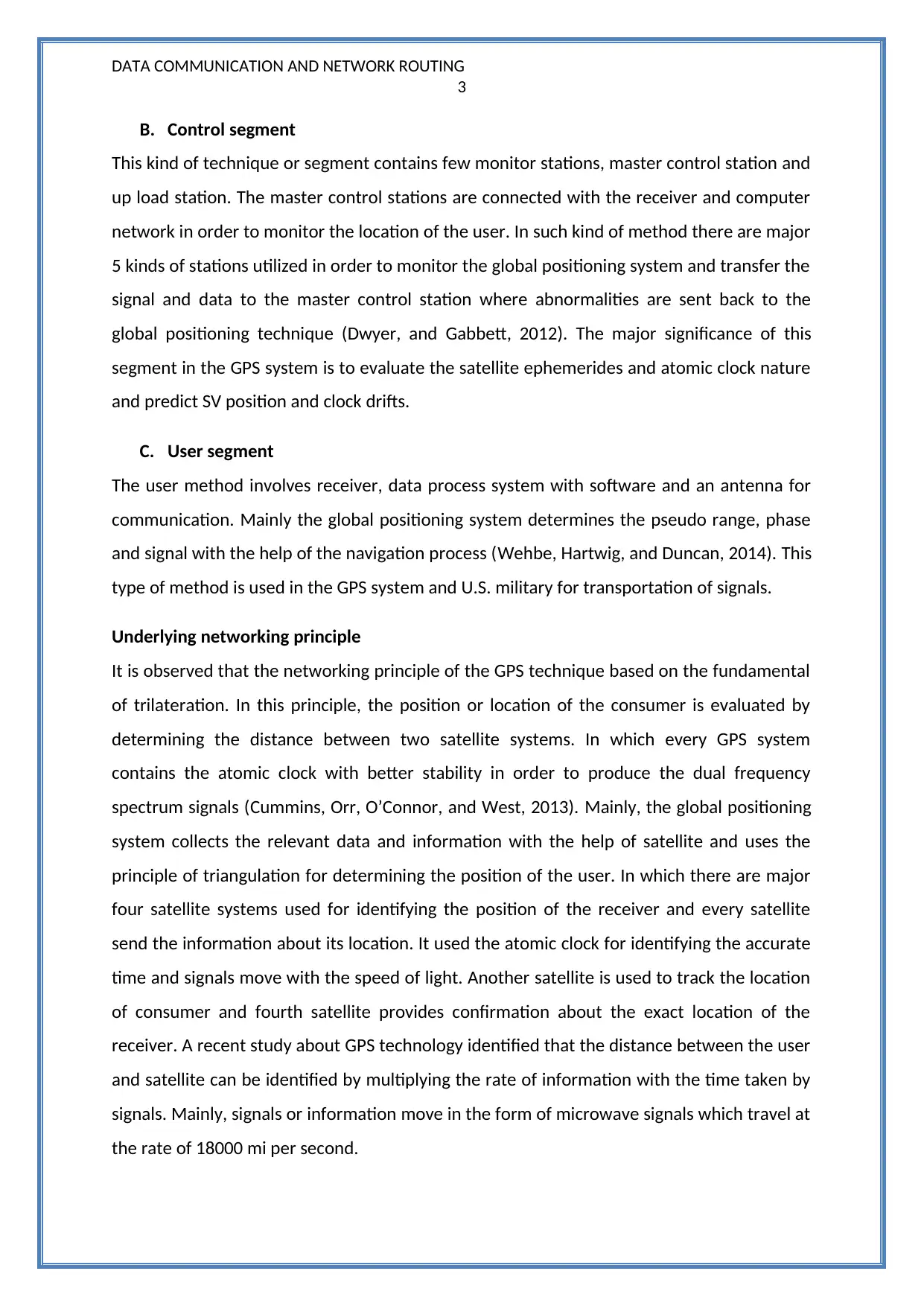
DATA COMMUNICATION AND NETWORK ROUTING
3
B. Control segment
This kind of technique or segment contains few monitor stations, master control station and
up load station. The master control stations are connected with the receiver and computer
network in order to monitor the location of the user. In such kind of method there are major
5 kinds of stations utilized in order to monitor the global positioning system and transfer the
signal and data to the master control station where abnormalities are sent back to the
global positioning technique (Dwyer, and Gabbett, 2012). The major significance of this
segment in the GPS system is to evaluate the satellite ephemerides and atomic clock nature
and predict SV position and clock drifts.
C. User segment
The user method involves receiver, data process system with software and an antenna for
communication. Mainly the global positioning system determines the pseudo range, phase
and signal with the help of the navigation process (Wehbe, Hartwig, and Duncan, 2014). This
type of method is used in the GPS system and U.S. military for transportation of signals.
Underlying networking principle
It is observed that the networking principle of the GPS technique based on the fundamental
of trilateration. In this principle, the position or location of the consumer is evaluated by
determining the distance between two satellite systems. In which every GPS system
contains the atomic clock with better stability in order to produce the dual frequency
spectrum signals (Cummins, Orr, O’Connor, and West, 2013). Mainly, the global positioning
system collects the relevant data and information with the help of satellite and uses the
principle of triangulation for determining the position of the user. In which there are major
four satellite systems used for identifying the position of the receiver and every satellite
send the information about its location. It used the atomic clock for identifying the accurate
time and signals move with the speed of light. Another satellite is used to track the location
of consumer and fourth satellite provides confirmation about the exact location of the
receiver. A recent study about GPS technology identified that the distance between the user
and satellite can be identified by multiplying the rate of information with the time taken by
signals. Mainly, signals or information move in the form of microwave signals which travel at
the rate of 18000 mi per second.
3
B. Control segment
This kind of technique or segment contains few monitor stations, master control station and
up load station. The master control stations are connected with the receiver and computer
network in order to monitor the location of the user. In such kind of method there are major
5 kinds of stations utilized in order to monitor the global positioning system and transfer the
signal and data to the master control station where abnormalities are sent back to the
global positioning technique (Dwyer, and Gabbett, 2012). The major significance of this
segment in the GPS system is to evaluate the satellite ephemerides and atomic clock nature
and predict SV position and clock drifts.
C. User segment
The user method involves receiver, data process system with software and an antenna for
communication. Mainly the global positioning system determines the pseudo range, phase
and signal with the help of the navigation process (Wehbe, Hartwig, and Duncan, 2014). This
type of method is used in the GPS system and U.S. military for transportation of signals.
Underlying networking principle
It is observed that the networking principle of the GPS technique based on the fundamental
of trilateration. In this principle, the position or location of the consumer is evaluated by
determining the distance between two satellite systems. In which every GPS system
contains the atomic clock with better stability in order to produce the dual frequency
spectrum signals (Cummins, Orr, O’Connor, and West, 2013). Mainly, the global positioning
system collects the relevant data and information with the help of satellite and uses the
principle of triangulation for determining the position of the user. In which there are major
four satellite systems used for identifying the position of the receiver and every satellite
send the information about its location. It used the atomic clock for identifying the accurate
time and signals move with the speed of light. Another satellite is used to track the location
of consumer and fourth satellite provides confirmation about the exact location of the
receiver. A recent study about GPS technology identified that the distance between the user
and satellite can be identified by multiplying the rate of information with the time taken by
signals. Mainly, signals or information move in the form of microwave signals which travel at
the rate of 18000 mi per second.
Paraphrase This Document
Need a fresh take? Get an instant paraphrase of this document with our AI Paraphraser
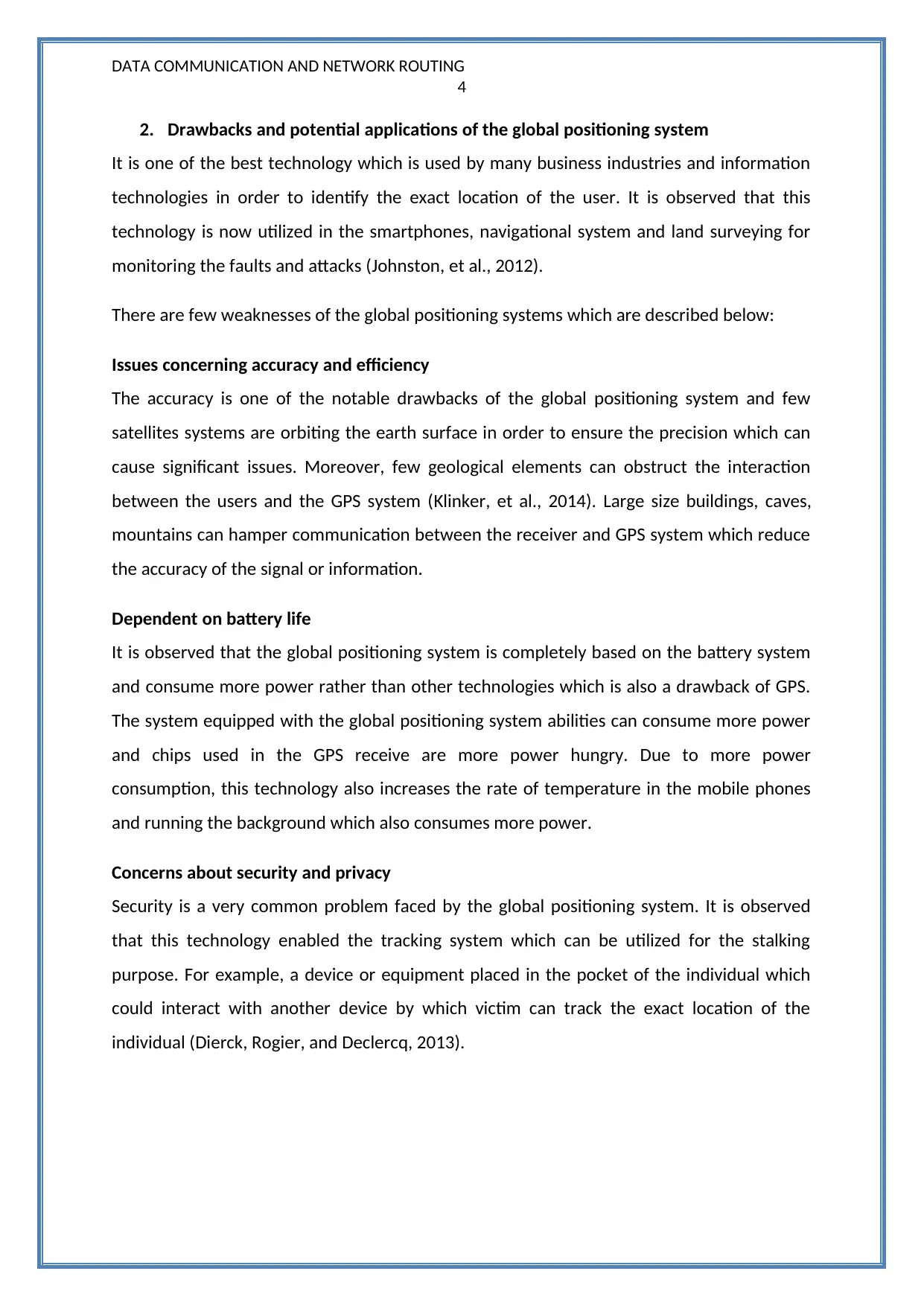
DATA COMMUNICATION AND NETWORK ROUTING
4
2. Drawbacks and potential applications of the global positioning system
It is one of the best technology which is used by many business industries and information
technologies in order to identify the exact location of the user. It is observed that this
technology is now utilized in the smartphones, navigational system and land surveying for
monitoring the faults and attacks (Johnston, et al., 2012).
There are few weaknesses of the global positioning systems which are described below:
Issues concerning accuracy and efficiency
The accuracy is one of the notable drawbacks of the global positioning system and few
satellites systems are orbiting the earth surface in order to ensure the precision which can
cause significant issues. Moreover, few geological elements can obstruct the interaction
between the users and the GPS system (Klinker, et al., 2014). Large size buildings, caves,
mountains can hamper communication between the receiver and GPS system which reduce
the accuracy of the signal or information.
Dependent on battery life
It is observed that the global positioning system is completely based on the battery system
and consume more power rather than other technologies which is also a drawback of GPS.
The system equipped with the global positioning system abilities can consume more power
and chips used in the GPS receive are more power hungry. Due to more power
consumption, this technology also increases the rate of temperature in the mobile phones
and running the background which also consumes more power.
Concerns about security and privacy
Security is a very common problem faced by the global positioning system. It is observed
that this technology enabled the tracking system which can be utilized for the stalking
purpose. For example, a device or equipment placed in the pocket of the individual which
could interact with another device by which victim can track the exact location of the
individual (Dierck, Rogier, and Declercq, 2013).
4
2. Drawbacks and potential applications of the global positioning system
It is one of the best technology which is used by many business industries and information
technologies in order to identify the exact location of the user. It is observed that this
technology is now utilized in the smartphones, navigational system and land surveying for
monitoring the faults and attacks (Johnston, et al., 2012).
There are few weaknesses of the global positioning systems which are described below:
Issues concerning accuracy and efficiency
The accuracy is one of the notable drawbacks of the global positioning system and few
satellites systems are orbiting the earth surface in order to ensure the precision which can
cause significant issues. Moreover, few geological elements can obstruct the interaction
between the users and the GPS system (Klinker, et al., 2014). Large size buildings, caves,
mountains can hamper communication between the receiver and GPS system which reduce
the accuracy of the signal or information.
Dependent on battery life
It is observed that the global positioning system is completely based on the battery system
and consume more power rather than other technologies which is also a drawback of GPS.
The system equipped with the global positioning system abilities can consume more power
and chips used in the GPS receive are more power hungry. Due to more power
consumption, this technology also increases the rate of temperature in the mobile phones
and running the background which also consumes more power.
Concerns about security and privacy
Security is a very common problem faced by the global positioning system. It is observed
that this technology enabled the tracking system which can be utilized for the stalking
purpose. For example, a device or equipment placed in the pocket of the individual which
could interact with another device by which victim can track the exact location of the
individual (Dierck, Rogier, and Declercq, 2013).
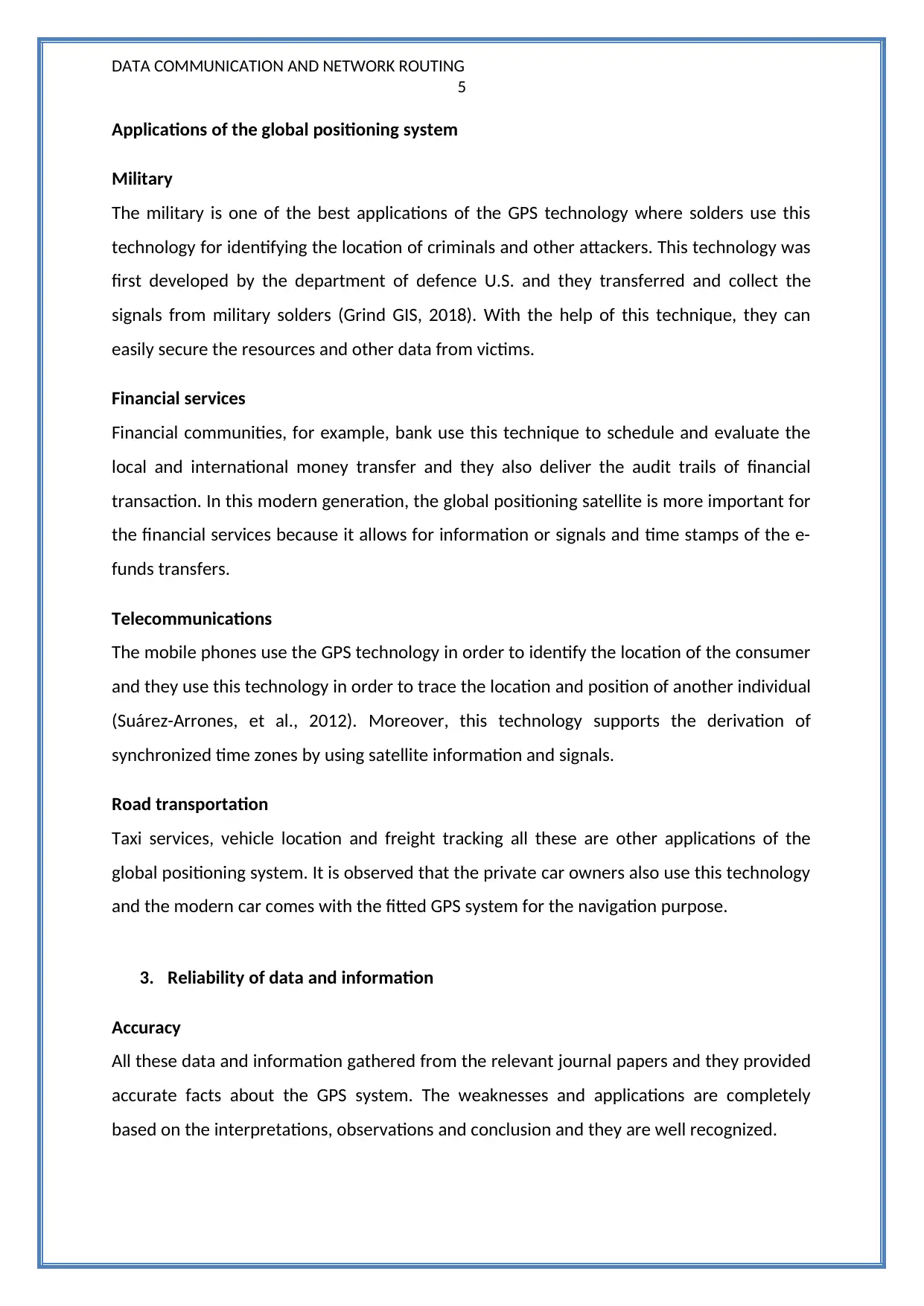
DATA COMMUNICATION AND NETWORK ROUTING
5
Applications of the global positioning system
Military
The military is one of the best applications of the GPS technology where solders use this
technology for identifying the location of criminals and other attackers. This technology was
first developed by the department of defence U.S. and they transferred and collect the
signals from military solders (Grind GIS, 2018). With the help of this technique, they can
easily secure the resources and other data from victims.
Financial services
Financial communities, for example, bank use this technique to schedule and evaluate the
local and international money transfer and they also deliver the audit trails of financial
transaction. In this modern generation, the global positioning satellite is more important for
the financial services because it allows for information or signals and time stamps of the e-
funds transfers.
Telecommunications
The mobile phones use the GPS technology in order to identify the location of the consumer
and they use this technology in order to trace the location and position of another individual
(Suárez-Arrones, et al., 2012). Moreover, this technology supports the derivation of
synchronized time zones by using satellite information and signals.
Road transportation
Taxi services, vehicle location and freight tracking all these are other applications of the
global positioning system. It is observed that the private car owners also use this technology
and the modern car comes with the fitted GPS system for the navigation purpose.
3. Reliability of data and information
Accuracy
All these data and information gathered from the relevant journal papers and they provided
accurate facts about the GPS system. The weaknesses and applications are completely
based on the interpretations, observations and conclusion and they are well recognized.
5
Applications of the global positioning system
Military
The military is one of the best applications of the GPS technology where solders use this
technology for identifying the location of criminals and other attackers. This technology was
first developed by the department of defence U.S. and they transferred and collect the
signals from military solders (Grind GIS, 2018). With the help of this technique, they can
easily secure the resources and other data from victims.
Financial services
Financial communities, for example, bank use this technique to schedule and evaluate the
local and international money transfer and they also deliver the audit trails of financial
transaction. In this modern generation, the global positioning satellite is more important for
the financial services because it allows for information or signals and time stamps of the e-
funds transfers.
Telecommunications
The mobile phones use the GPS technology in order to identify the location of the consumer
and they use this technology in order to trace the location and position of another individual
(Suárez-Arrones, et al., 2012). Moreover, this technology supports the derivation of
synchronized time zones by using satellite information and signals.
Road transportation
Taxi services, vehicle location and freight tracking all these are other applications of the
global positioning system. It is observed that the private car owners also use this technology
and the modern car comes with the fitted GPS system for the navigation purpose.
3. Reliability of data and information
Accuracy
All these data and information gathered from the relevant journal papers and they provided
accurate facts about the GPS system. The weaknesses and applications are completely
based on the interpretations, observations and conclusion and they are well recognized.
⊘ This is a preview!⊘
Do you want full access?
Subscribe today to unlock all pages.

Trusted by 1+ million students worldwide
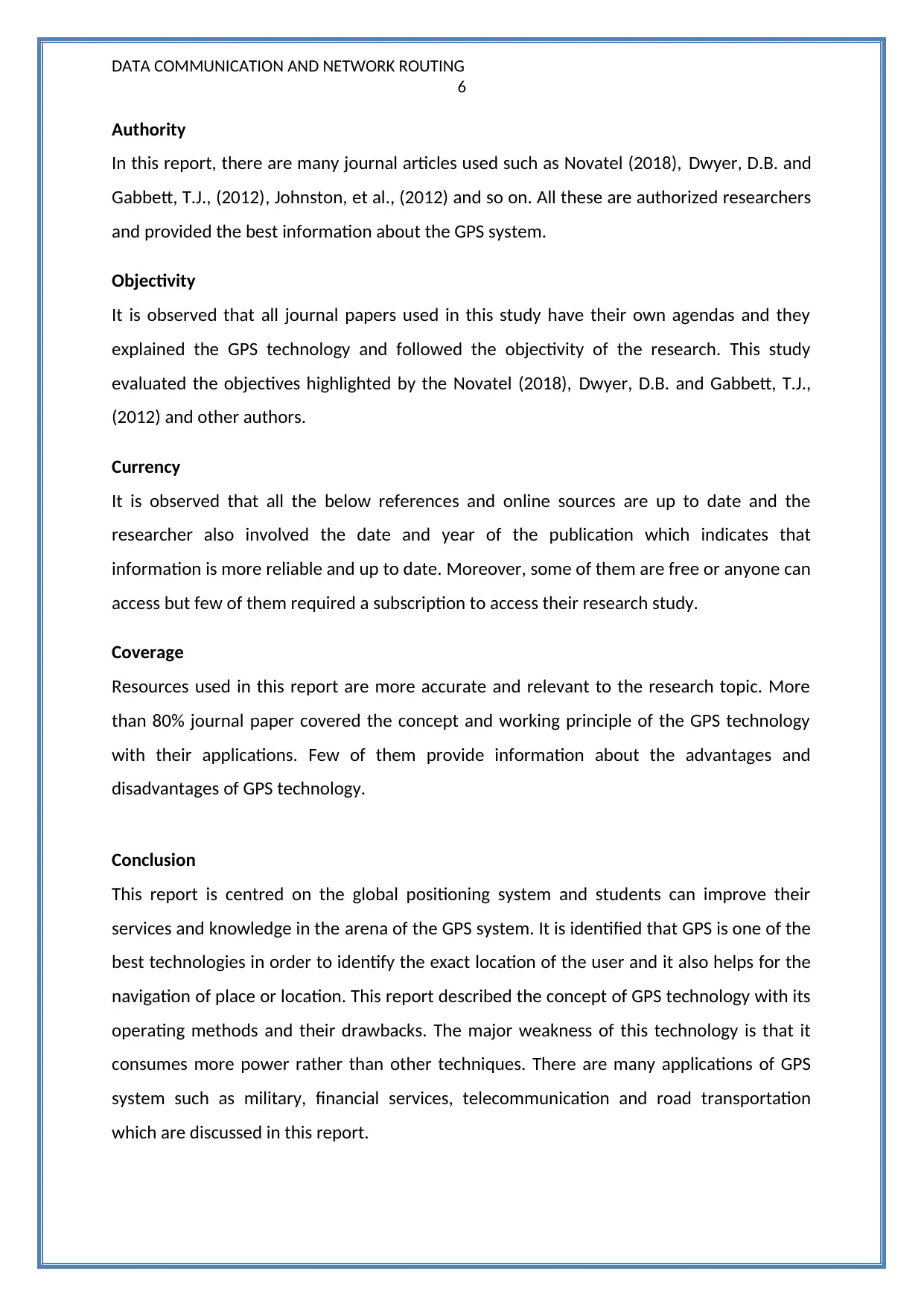
DATA COMMUNICATION AND NETWORK ROUTING
6
Authority
In this report, there are many journal articles used such as Novatel (2018), Dwyer, D.B. and
Gabbett, T.J., (2012), Johnston, et al., (2012) and so on. All these are authorized researchers
and provided the best information about the GPS system.
Objectivity
It is observed that all journal papers used in this study have their own agendas and they
explained the GPS technology and followed the objectivity of the research. This study
evaluated the objectives highlighted by the Novatel (2018), Dwyer, D.B. and Gabbett, T.J.,
(2012) and other authors.
Currency
It is observed that all the below references and online sources are up to date and the
researcher also involved the date and year of the publication which indicates that
information is more reliable and up to date. Moreover, some of them are free or anyone can
access but few of them required a subscription to access their research study.
Coverage
Resources used in this report are more accurate and relevant to the research topic. More
than 80% journal paper covered the concept and working principle of the GPS technology
with their applications. Few of them provide information about the advantages and
disadvantages of GPS technology.
Conclusion
This report is centred on the global positioning system and students can improve their
services and knowledge in the arena of the GPS system. It is identified that GPS is one of the
best technologies in order to identify the exact location of the user and it also helps for the
navigation of place or location. This report described the concept of GPS technology with its
operating methods and their drawbacks. The major weakness of this technology is that it
consumes more power rather than other techniques. There are many applications of GPS
system such as military, financial services, telecommunication and road transportation
which are discussed in this report.
6
Authority
In this report, there are many journal articles used such as Novatel (2018), Dwyer, D.B. and
Gabbett, T.J., (2012), Johnston, et al., (2012) and so on. All these are authorized researchers
and provided the best information about the GPS system.
Objectivity
It is observed that all journal papers used in this study have their own agendas and they
explained the GPS technology and followed the objectivity of the research. This study
evaluated the objectives highlighted by the Novatel (2018), Dwyer, D.B. and Gabbett, T.J.,
(2012) and other authors.
Currency
It is observed that all the below references and online sources are up to date and the
researcher also involved the date and year of the publication which indicates that
information is more reliable and up to date. Moreover, some of them are free or anyone can
access but few of them required a subscription to access their research study.
Coverage
Resources used in this report are more accurate and relevant to the research topic. More
than 80% journal paper covered the concept and working principle of the GPS technology
with their applications. Few of them provide information about the advantages and
disadvantages of GPS technology.
Conclusion
This report is centred on the global positioning system and students can improve their
services and knowledge in the arena of the GPS system. It is identified that GPS is one of the
best technologies in order to identify the exact location of the user and it also helps for the
navigation of place or location. This report described the concept of GPS technology with its
operating methods and their drawbacks. The major weakness of this technology is that it
consumes more power rather than other techniques. There are many applications of GPS
system such as military, financial services, telecommunication and road transportation
which are discussed in this report.
Paraphrase This Document
Need a fresh take? Get an instant paraphrase of this document with our AI Paraphraser
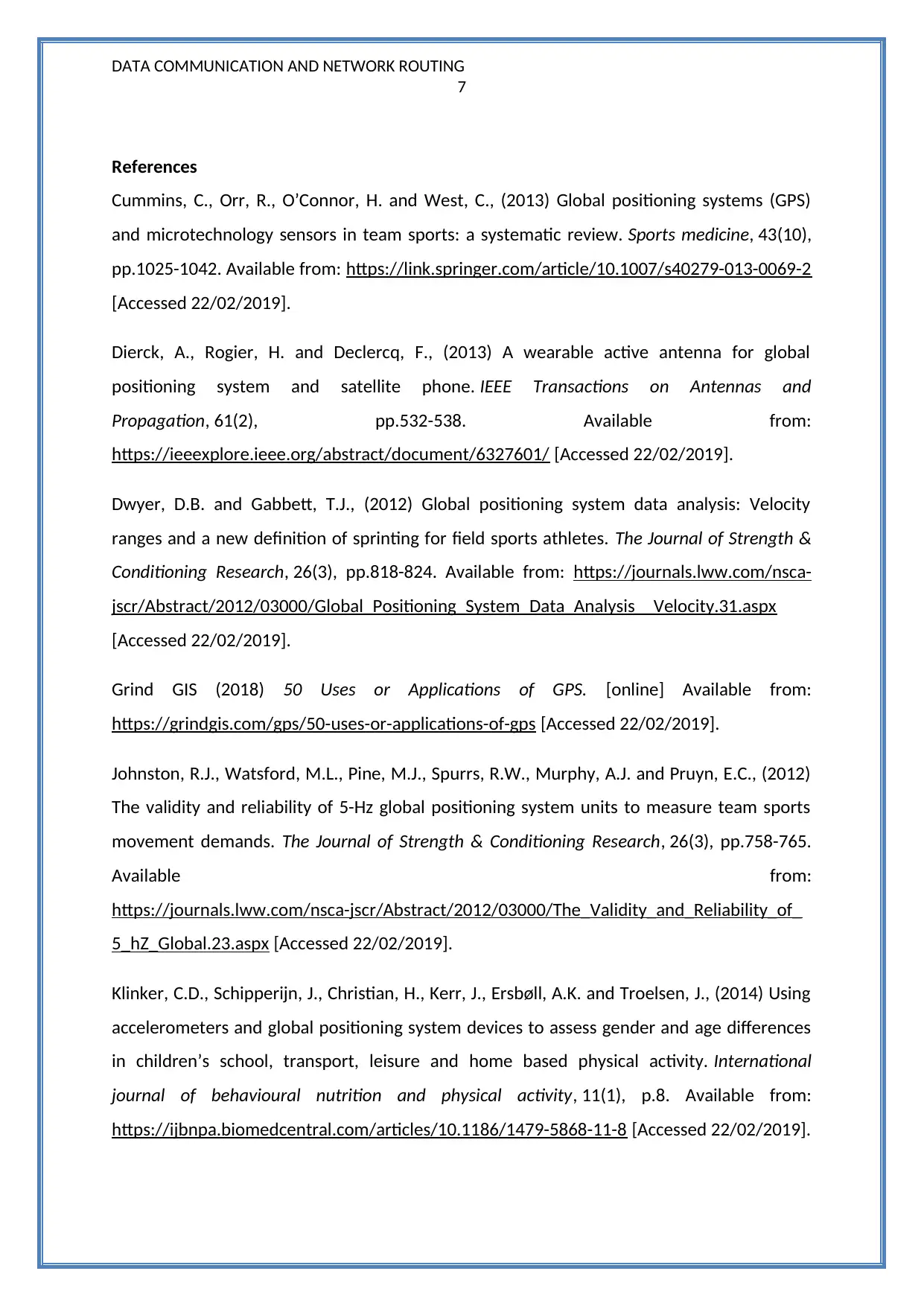
DATA COMMUNICATION AND NETWORK ROUTING
7
References
Cummins, C., Orr, R., O’Connor, H. and West, C., (2013) Global positioning systems (GPS)
and microtechnology sensors in team sports: a systematic review. Sports medicine, 43(10),
pp.1025-1042. Available from: https://link.springer.com/article/10.1007/s40279-013-0069-2
[Accessed 22/02/2019].
Dierck, A., Rogier, H. and Declercq, F., (2013) A wearable active antenna for global
positioning system and satellite phone. IEEE Transactions on Antennas and
Propagation, 61(2), pp.532-538. Available from:
https://ieeexplore.ieee.org/abstract/document/6327601/ [Accessed 22/02/2019].
Dwyer, D.B. and Gabbett, T.J., (2012) Global positioning system data analysis: Velocity
ranges and a new definition of sprinting for field sports athletes. The Journal of Strength &
Conditioning Research, 26(3), pp.818-824. Available from: https://journals.lww.com/nsca-
jscr/Abstract/2012/03000/Global_Positioning_System_Data_Analysis__Velocity.31.aspx
[Accessed 22/02/2019].
Grind GIS (2018) 50 Uses or Applications of GPS. [online] Available from:
https://grindgis.com/gps/50-uses-or-applications-of-gps [Accessed 22/02/2019].
Johnston, R.J., Watsford, M.L., Pine, M.J., Spurrs, R.W., Murphy, A.J. and Pruyn, E.C., (2012)
The validity and reliability of 5-Hz global positioning system units to measure team sports
movement demands. The Journal of Strength & Conditioning Research, 26(3), pp.758-765.
Available from:
https://journals.lww.com/nsca-jscr/Abstract/2012/03000/The_Validity_and_Reliability_of_
5_hZ_Global.23.aspx [Accessed 22/02/2019].
Klinker, C.D., Schipperijn, J., Christian, H., Kerr, J., Ersbøll, A.K. and Troelsen, J., (2014) Using
accelerometers and global positioning system devices to assess gender and age differences
in children’s school, transport, leisure and home based physical activity. International
journal of behavioural nutrition and physical activity, 11(1), p.8. Available from:
https://ijbnpa.biomedcentral.com/articles/10.1186/1479-5868-11-8 [Accessed 22/02/2019].
7
References
Cummins, C., Orr, R., O’Connor, H. and West, C., (2013) Global positioning systems (GPS)
and microtechnology sensors in team sports: a systematic review. Sports medicine, 43(10),
pp.1025-1042. Available from: https://link.springer.com/article/10.1007/s40279-013-0069-2
[Accessed 22/02/2019].
Dierck, A., Rogier, H. and Declercq, F., (2013) A wearable active antenna for global
positioning system and satellite phone. IEEE Transactions on Antennas and
Propagation, 61(2), pp.532-538. Available from:
https://ieeexplore.ieee.org/abstract/document/6327601/ [Accessed 22/02/2019].
Dwyer, D.B. and Gabbett, T.J., (2012) Global positioning system data analysis: Velocity
ranges and a new definition of sprinting for field sports athletes. The Journal of Strength &
Conditioning Research, 26(3), pp.818-824. Available from: https://journals.lww.com/nsca-
jscr/Abstract/2012/03000/Global_Positioning_System_Data_Analysis__Velocity.31.aspx
[Accessed 22/02/2019].
Grind GIS (2018) 50 Uses or Applications of GPS. [online] Available from:
https://grindgis.com/gps/50-uses-or-applications-of-gps [Accessed 22/02/2019].
Johnston, R.J., Watsford, M.L., Pine, M.J., Spurrs, R.W., Murphy, A.J. and Pruyn, E.C., (2012)
The validity and reliability of 5-Hz global positioning system units to measure team sports
movement demands. The Journal of Strength & Conditioning Research, 26(3), pp.758-765.
Available from:
https://journals.lww.com/nsca-jscr/Abstract/2012/03000/The_Validity_and_Reliability_of_
5_hZ_Global.23.aspx [Accessed 22/02/2019].
Klinker, C.D., Schipperijn, J., Christian, H., Kerr, J., Ersbøll, A.K. and Troelsen, J., (2014) Using
accelerometers and global positioning system devices to assess gender and age differences
in children’s school, transport, leisure and home based physical activity. International
journal of behavioural nutrition and physical activity, 11(1), p.8. Available from:
https://ijbnpa.biomedcentral.com/articles/10.1186/1479-5868-11-8 [Accessed 22/02/2019].
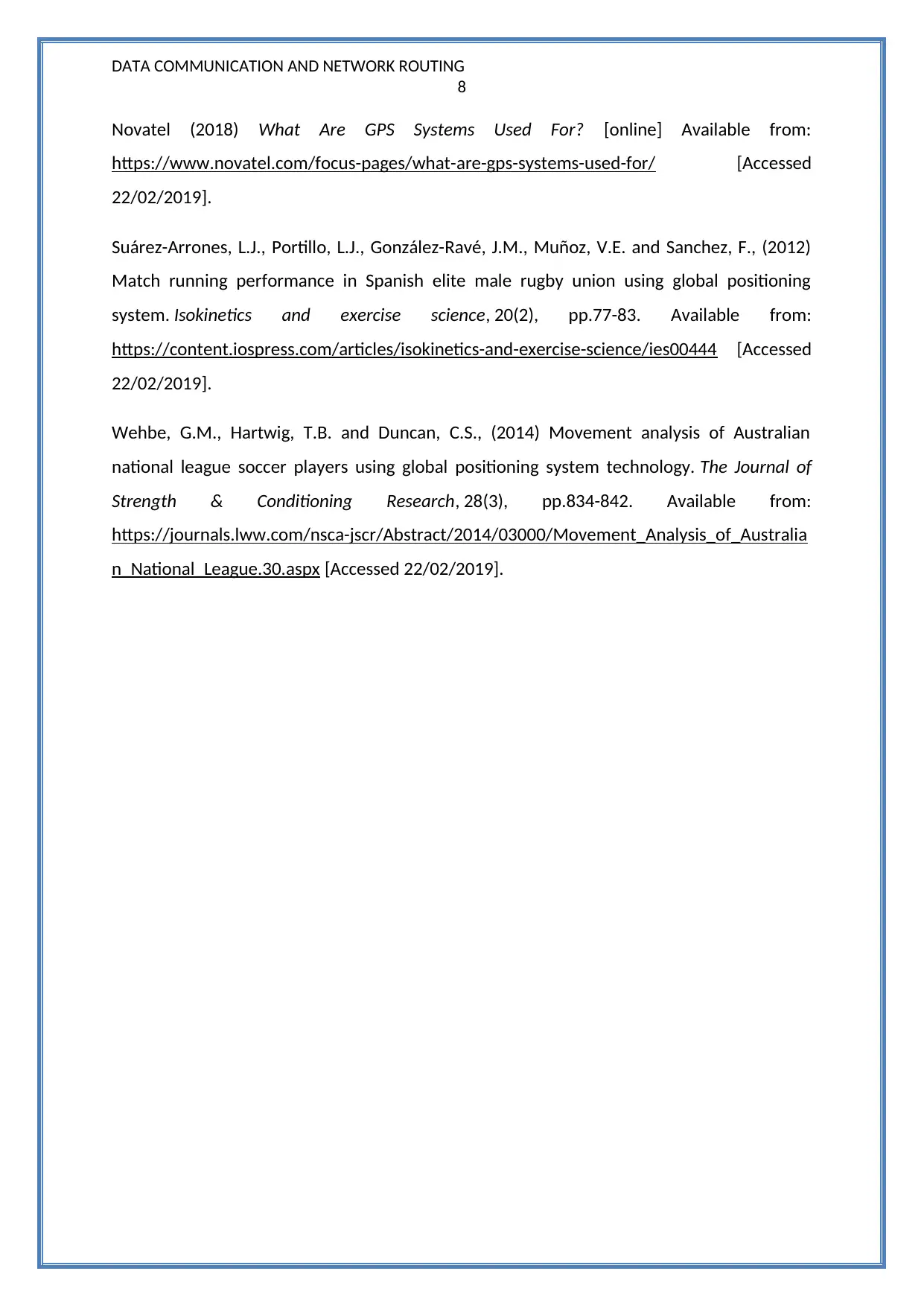
DATA COMMUNICATION AND NETWORK ROUTING
8
Novatel (2018) What Are GPS Systems Used For? [online] Available from:
https://www.novatel.com/focus-pages/what-are-gps-systems-used-for/ [Accessed
22/02/2019].
Suárez-Arrones, L.J., Portillo, L.J., González-Ravé, J.M., Muñoz, V.E. and Sanchez, F., (2012)
Match running performance in Spanish elite male rugby union using global positioning
system. Isokinetics and exercise science, 20(2), pp.77-83. Available from:
https://content.iospress.com/articles/isokinetics-and-exercise-science/ies00444 [Accessed
22/02/2019].
Wehbe, G.M., Hartwig, T.B. and Duncan, C.S., (2014) Movement analysis of Australian
national league soccer players using global positioning system technology. The Journal of
Strength & Conditioning Research, 28(3), pp.834-842. Available from:
https://journals.lww.com/nsca-jscr/Abstract/2014/03000/Movement_Analysis_of_Australia
n_National_League.30.aspx [Accessed 22/02/2019].
8
Novatel (2018) What Are GPS Systems Used For? [online] Available from:
https://www.novatel.com/focus-pages/what-are-gps-systems-used-for/ [Accessed
22/02/2019].
Suárez-Arrones, L.J., Portillo, L.J., González-Ravé, J.M., Muñoz, V.E. and Sanchez, F., (2012)
Match running performance in Spanish elite male rugby union using global positioning
system. Isokinetics and exercise science, 20(2), pp.77-83. Available from:
https://content.iospress.com/articles/isokinetics-and-exercise-science/ies00444 [Accessed
22/02/2019].
Wehbe, G.M., Hartwig, T.B. and Duncan, C.S., (2014) Movement analysis of Australian
national league soccer players using global positioning system technology. The Journal of
Strength & Conditioning Research, 28(3), pp.834-842. Available from:
https://journals.lww.com/nsca-jscr/Abstract/2014/03000/Movement_Analysis_of_Australia
n_National_League.30.aspx [Accessed 22/02/2019].
⊘ This is a preview!⊘
Do you want full access?
Subscribe today to unlock all pages.

Trusted by 1+ million students worldwide
1 out of 9
Related Documents
Your All-in-One AI-Powered Toolkit for Academic Success.
+13062052269
info@desklib.com
Available 24*7 on WhatsApp / Email
![[object Object]](/_next/static/media/star-bottom.7253800d.svg)
Unlock your academic potential
Copyright © 2020–2025 A2Z Services. All Rights Reserved. Developed and managed by ZUCOL.



